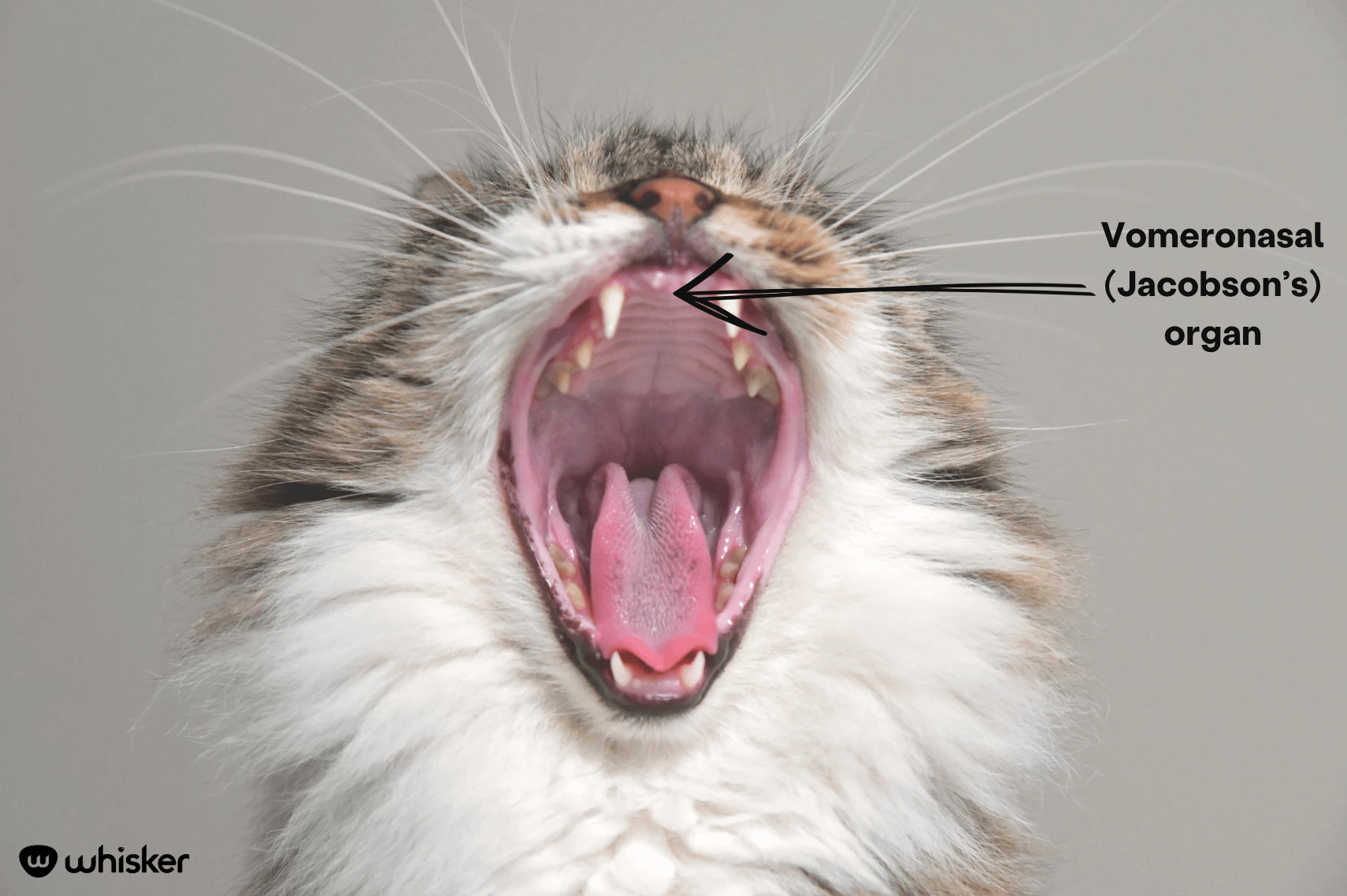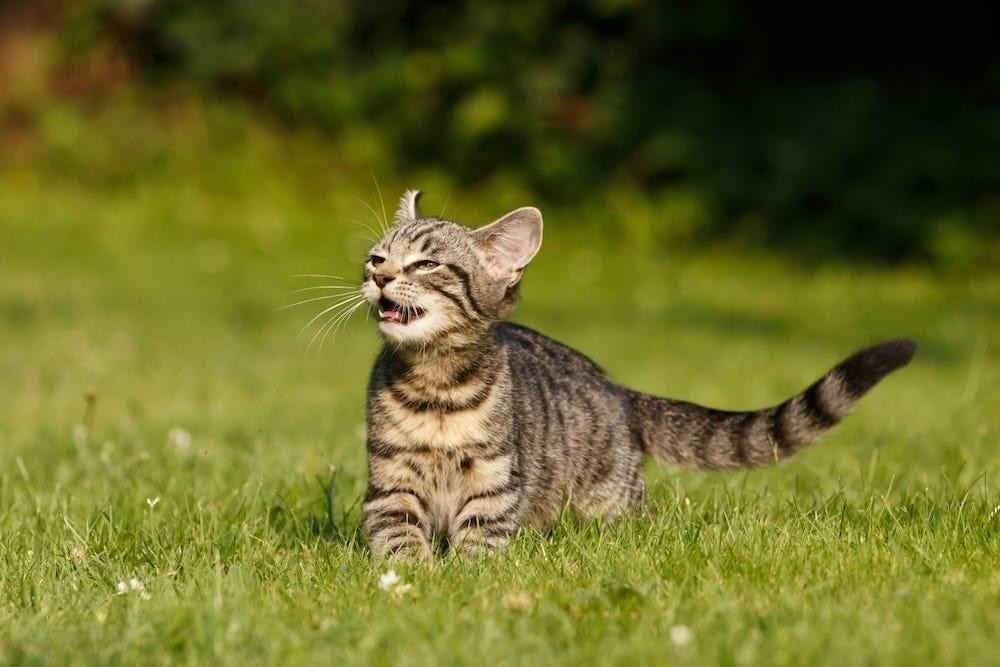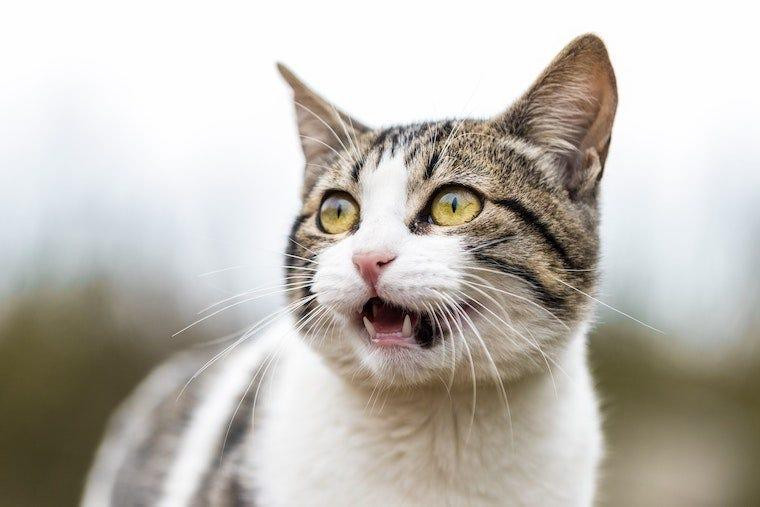Does your feline friend sometimes make a funny face after sniffing something, like they’re caught in a moment of comical surprise? The answer is yes, and at solcat.net, we’re here to decode this curious cat behavior! This “stinky face,” known as the flehmen response, is a fascinating way for cats to analyze scents. Let’s explore this unique feline trait and how it helps your cat understand the world around them, including scent marking, pheromone detection and olfactory investigation.
1. What is the Flehmen Response in Cats?
The flehmen response is a voluntary behavior where a cat opens its mouth slightly after smelling something intriguing, allowing scents to reach the vomeronasal organ (Jacobson’s organ). This action helps cats analyze complex scents more effectively than through normal sniffing. According to research from the Cornell Feline Health Center, in July 2025, the flehmen response enhances a cat’s ability to detect pheromones and other chemical signals.
Following are more details of the Flehmen Response in cats:
- Purpose: The flehmen response is a specialized way for cats to detect and analyze scents, particularly pheromones and other chemical signals.
- Mechanism: It involves the cat slightly opening its mouth, raising its upper lip, and wrinkling its nose, which allows air to pass over the vomeronasal organ (Jacobson’s organ) located in the roof of the mouth.
- Vomeronasal Organ: This organ is specifically designed to detect pheromones, which are chemical signals that cats use to communicate with each other.
- Enhanced Scent Detection: The flehmen response allows cats to gather more information from scents than they would through normal sniffing.
- Communication: By analyzing pheromones, cats can gain insights into the sex, age, social status, and reproductive state of other cats in their environment.
 Cat using the flehmen response to analyze a scent
Cat using the flehmen response to analyze a scent
2. What Does the Flehmen Response Look Like?
The flehmen response appears as a cat slightly opening its mouth, often curling back the upper lip, and sometimes squinting or widening its eyes as it focuses intently on the scent. This “stinky face” usually lasts only a few seconds before the cat returns to normal. According to Theresa L. DePorter in Feline Behavioral Health and Welfare, this gape allows cats to gather pheromones effectively.
Recognizing the flehmen response:
- Slightly open mouth: The cat’s mouth will be slightly open, often giving the impression of a grimace or funny expression.
- Curled back upper lip: The upper lip is often curled back, exposing the upper teeth.
- Intense focus: The cat may appear to be squinting or widening its eyes as it focuses on the scent.
- Short duration: The flehmen response typically lasts only a few seconds before the cat returns to normal.
3. Why Do Cats Exhibit the Flehmen Response?
Cats exhibit the flehmen response primarily to analyze pheromones and other complex scents, aiding in communication, mating, and understanding their environment. Male cats, especially unneutered ones, use it more frequently due to their heightened sensitivity to mating-related pheromones. Bradshaw notes that tabby cats have 30 different types of receptors in the vomeronasal organ, while hound dogs have only 9.
Reasons why cats exhibit the flehmen response:
- Pheromone Detection: Cats use the flehmen response to detect pheromones, which are chemical signals that play a crucial role in feline communication.
- Communication: Pheromones convey information about sex, age, social status, and reproductive state, allowing cats to understand their environment and interact with other cats.
- Mating: Male cats use the flehmen response to detect pheromones from female cats in heat, helping them to locate potential mates.
- Environmental Analysis: The flehmen response also helps cats analyze other scents in their environment, such as those from urine markings, new objects, and food.
4. When Do Cats Use the Flehmen Response?
Cats most often use the flehmen response when encountering strong or unfamiliar scents, such as urine markings from other cats, pheromones from a female in heat, or new objects in their territory. Mother cats also use it to identify and monitor their kittens through scent. The American Animal Hospital Association (AAHA) highlights that this behavior is more common in areas with concentrated scents like litter boxes and doorways.
Common situations for the flehmen response:
- Urine or Scent Markings: Cats use the flehmen response when they encounter urine or scent markings from other cats, as these markings contain pheromones that convey important information.
- Female Cat Pheromones: Male cats often use the flehmen response when detecting the pheromones of a female cat in heat, which signals that she is ready to mate.
- Tracking Kittens: Mother cats use the flehmen response to identify and monitor their kittens through scent, ensuring they stay close and safe.
- New or Strong-Smelling Objects: Cats may use the flehmen response when they encounter new or strong-smelling objects, such as certain foods, plants, or even human sweat, to analyze the scent and determine if it is safe or interesting.
- Household Smells: Sometimes, cats exhibit the flehmen response in response to everyday household smells that carry a particularly intriguing or unfamiliar scent, indicating that they are trying to understand something new in their environment.
5. Where Do Cats Exhibit the Flehmen Response?
Cats commonly exhibit the flehmen response in areas where scents are concentrated, such as litter boxes, doorways, walls, and on items like shoes or bags that carry interesting smells from outside. These locations often have a higher concentration of pheromones and other scents that cats want to analyze.
Areas where scents are concentrated:
- Litter Boxes: Litter boxes are hotspots for pheromones, making them one of the most common places to observe the flehmen response.
- Doorways and Walls: If another cat has rubbed or marked a spot, your cat may detect it and use the flehmen response to investigate.
- Shoes or Bags: Items that have been outside can carry interesting smells for your cat to analyze, prompting the flehmen response.
- Furniture or Blankets: If new scents are present on furniture or blankets, your cat may use the flehmen response to investigate their origin and significance.
 Brown and white tabby using flehmen response outdoors
Brown and white tabby using flehmen response outdoors
6. How Can You Tell the Difference Between Flehmen Response and Open-Mouth Breathing?
Differentiating between the flehmen response and open-mouth breathing is crucial. The flehmen response is a normal behavior triggered by scents, while open-mouth breathing can indicate respiratory distress. The key differences lie in the context and accompanying symptoms.
Here’s how to tell the difference:
| Behavior | Description | Key Differences |
|---|---|---|
| Flehmen Response | Mouth slightly open, lip curled, sniffing intensely | Happens after sniffing something specific, short-lived, and normal behavior |
| Panting | Mouth open, rapid breathing | Can be due to stress, heat, or overexertion; not scent-related |
| Sneezing | Sudden, forceful exhale through the nose | Happens due to dust, allergies, or illness |
| Yawning | Wide mouth opening, stretching jaws | Associated with tiredness or relaxation |
| Teeth Chattering | Rapid jaw movement, clicking sounds | Usually seen when watching birds or prey animals (linked to hunting instinct) |
| Asthma | Labored breathing, wheezing, coughing | Can occur suddenly, often during activity or stress; may worsen over time |
| Heat Stroke | Excessive panting, drooling, lethargy, vomiting | Caused by overheating, requires immediate cooling and vet attention |
| Poisoning | Drooling, vomiting, seizures, lethargy | Usually follows ingestion of a toxic substance; needs urgent vet care |
| Hyperthyroidism | Increased thirst, weight loss, hyperactivity | Long-term condition, usually affects older cats; panting can be a sign, especially after playing or exertion. |
7. Is the Flehmen Response Common in Other Animals?
Yes, the flehmen response is not unique to cats; it’s observed in various animals like dogs, horses, llamas, goats, and even lions and tigers. This behavior helps these animals better understand their environment through enhanced scent analysis. According to a study in Animal Behaviour, the flehmen response is widespread among mammals, serving a similar function in each species.
Here is a list of other animals that exhibit the Flehmen Response:
- Dogs
- Horses
- Llamas
- Goats
- Lions
- Tigers
- Camels
- Tapirs
- Rhinos
- Rams
- Elk
- Giraffes
- Buffalos
- Hedgehogs
 Lioness using flehmen response
Lioness using flehmen response
8. What Other Behaviors Might Be Confused with the Flehmen Response?
Sometimes, cat owners might confuse the flehmen response with other actions like panting, sneezing, or open-mouth breathing due to respiratory issues. Panting, for example, involves rapid breathing and can be a sign of stress, heat, or overexertion, while the flehmen response is a deliberate action after sniffing something specific.
Here are behaviors to consider not confusing with the flehmen response:
- Panting: Unlike the Flehmen response, panting involves rapid breathing and can be a sign of stress, heat, or overexertion.
- Sneezing: Sneezing is a sudden, forceful exhale through the nose, usually caused by dust, allergies, or illness, and should not be confused with the Flehmen response.
- Open-Mouth Breathing: Open-mouth breathing can be a sign of respiratory distress and requires immediate veterinary attention, distinguishing it from the normal Flehmen response.
9. How Does Catnip Trigger the Flehmen Response?
Catnip contains a chemical called nepetalactone, which triggers a response in a cat’s brain when inhaled or ingested, often leading to the flehmen response. This chemical mimics pheromones, causing the cat to exhibit behaviors associated with mating or marking territory, as noted by the Veterinary Information Network.
Here’s how catnip works in triggering the flehmen response:
- Nepetalactone: Catnip contains a chemical called nepetalactone, which is responsible for its effects on cats.
- Pheromone Mimicry: Nepetalactone mimics pheromones, which are chemical signals that cats use to communicate with each other.
- Brain Response: When a cat inhales or ingests nepetalactone, it triggers a response in the brain, causing the cat to exhibit behaviors associated with mating or marking territory.
- Flehmen Response Trigger: The flehmen response is one of the behaviors that can be triggered by nepetalactone, as the cat attempts to analyze the scent and understand its meaning.
10. What Can You Learn About Your Cat from Observing the Flehmen Response?
Observing the flehmen response can provide insights into what scents your cat finds interesting or important, helping you understand their preferences and how they perceive their environment. It can also indicate what types of pheromones they are detecting, offering clues about their social interactions and reproductive status.
Here are some things you can learn:
- Scent Preferences: Observing which scents trigger the flehmen response can help you understand your cat’s preferences and what types of smells they find interesting or important.
- Pheromone Detection: The flehmen response can indicate what types of pheromones your cat is detecting, offering clues about their social interactions and reproductive status.
- Environmental Awareness: By observing the flehmen response, you can gain insights into how your cat perceives their environment and what types of scents they use to navigate and understand their surroundings.
- Health Insights: While the flehmen response is normal, observing changes in its frequency or intensity can sometimes indicate underlying health issues, making it important to monitor your cat’s behavior and consult with a veterinarian if you have concerns.
Understanding the flehmen response is just one piece of the puzzle when it comes to understanding your feline companion. At solcat.net, we’re dedicated to providing you with the most up-to-date and accurate information about cat behavior, health, and care. From understanding their quirky habits to providing the best nutrition and healthcare, we’re here to help you build a stronger bond with your cat.
Ready to dive deeper into the world of cats? Visit solcat.net today to explore our extensive library of articles, videos, and resources!
Need more information or have specific questions about your cat’s behavior? Contact us at:
- Address: 950 Alaskan Way, Seattle, WA 98104, United States
- Phone: +1 (206) 386-4000
- Website: solcat.net
 Brown and white tabby cat using flehmen response
Brown and white tabby cat using flehmen response
FAQ about the Flehmen Response
1. Is the flehmen response normal in all cats?
Yes, the flehmen response is a normal behavior in most cats, though some may exhibit it more frequently than others. Factors like age, sex, and exposure to strong scents can influence how often a cat displays this behavior.
2. Can kittens exhibit the flehmen response?
Yes, kittens can exhibit the flehmen response, although it may be less frequent than in adult cats. They use it to explore and understand their environment through scent.
3. Does the flehmen response indicate a health problem?
No, the flehmen response itself does not indicate a health problem. However, it’s important to differentiate it from signs of respiratory distress, such as panting or labored breathing, which require veterinary attention.
4. Why do male cats use the flehmen response more often?
Male cats, especially unneutered ones, use the flehmen response more often due to their heightened sensitivity to pheromones related to mating and territorial marking.
5. Can the flehmen response be triggered by human scents?
Yes, the flehmen response can be triggered by human scents, such as sweat or strong perfumes, if the cat finds the scent particularly interesting or unfamiliar.
6. Is there a way to encourage the flehmen response in cats?
You can encourage the flehmen response by introducing new and interesting scents to your cat’s environment, such as catnip or toys with novel smells.
7. What should I do if my cat is exhibiting the flehmen response frequently?
If your cat is exhibiting the flehmen response frequently, it is generally not a cause for concern. However, ensure that the environment is safe and that the cat is not exposed to any harmful substances.
8. Do neutered or spayed cats still exhibit the flehmen response?
Yes, neutered or spayed cats can still exhibit the flehmen response, although it may be less frequent, especially in males, due to reduced hormone levels.
9. How long does the flehmen response typically last?
The flehmen response typically lasts only a few seconds, but the duration can vary depending on the intensity of the scent and the cat’s individual sensitivity.
10. Are there any cats that don’t exhibit the flehmen response?
While most cats exhibit the flehmen response, some may do so less noticeably. Individual cats may have varying levels of sensitivity to scents and different behavioral responses.
11. What are some related cat behaviors that owners should be aware of?
Owners should be aware of related cat behaviors such as scent marking, kneading, and vocalizations. Scent marking involves rubbing or spraying urine to mark territory, while kneading is a rhythmic pushing motion with the paws, often associated with comfort. Understanding these behaviors can provide deeper insights into your cat’s needs and communication style.
At solcat.net, we understand that your cat is more than just a pet—they’re a member of your family. That’s why we’re committed to providing you with the resources and support you need to give them the best possible life. Visit us today and discover a world of information, tips, and advice to help you nurture and cherish your feline friend.
Visit solcat.net now and join our community of cat lovers!
We hope this guide has shed light on the fascinating flehmen response in cats. By understanding this unique behavior, you can gain a deeper appreciation for how your feline friend perceives and interacts with the world around them. Remember to visit solcat.net for more valuable insights and resources on all things cat-related!

